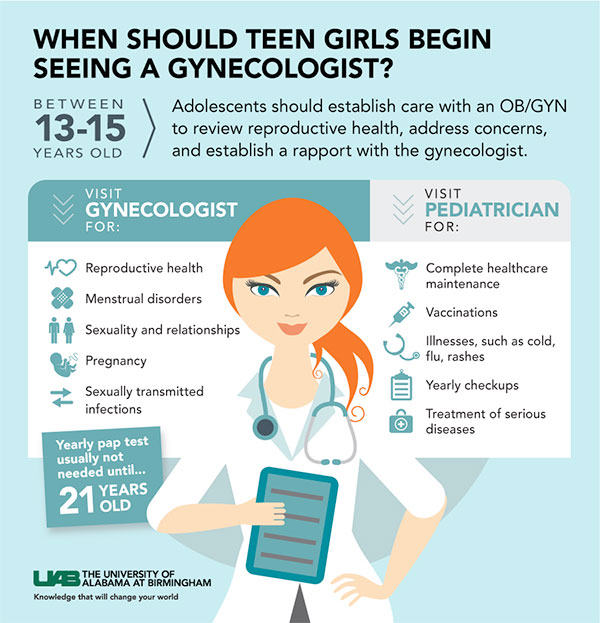For a parent of a girl, it is important to teach proper health care practices. Part of this is maintaining proper gynecological and reproductive care upon puberty. Two major questions that come up in regard to an adolescent’s seeing a gynecologist are when and why.
 “Having an open conversation with your daughter about her overall health is important at any age,” said Janeen Arbuckle, M.D., Ph.D., a pediatric obstetrician and gynecologist in the University of Alabama at Birmingham Division of Women’s Reproductive Healthcare. “We provide gynecological care to girls from birth to age 21.”
“Having an open conversation with your daughter about her overall health is important at any age,” said Janeen Arbuckle, M.D., Ph.D., a pediatric obstetrician and gynecologist in the University of Alabama at Birmingham Division of Women’s Reproductive Healthcare. “We provide gynecological care to girls from birth to age 21.”
The American College of Obstetricians and Gynecologists recommends that adolescents establish care with an OB/GYN between the ages of 13 and 15. This visit serves primarily as an opportunity for the adolescent to review her reproductive health, address any concerns she may have and establish a rapport with the gynecologist. Depending on her individual needs, she may then be seen periodically by the gynecologist.
“Timing can always be addressed with your child’s pediatrician,” Arbuckle said. “An adolescent should receive care from both pediatricians and gynecologists. Parents can help reassure their adolescent that her pediatrician and gynecologist work in collaboration to assure her overall health.”
A pediatrician provides more complete health care maintenance, while the gynecologist focuses on the reproductive health of the patient. Adolescents are often referred by their pediatricians to an OB/GYN for the evaluation and management of menstrual disorders, concerns regarding reproductive anatomy or for the initiation of contraception.
Gynecologists often address sensitive and private information with their patients, which is kept confidential. As the adolescent ages, she may elect to maintain her relationship with her gynecologist.
Common reasons for patients to pursue care with a gynecologist are concerns regarding pubertal development, abnormal periods, vaginal discharge and sexual behavior.
An important part of gynecological health is having a yearly Pap test. This is not typically necessary until age 21. However, an adolescent could see a gynecologist to address issues she may not be comfortable discussing with her parents or pediatrician, ensuring that her overall health is intact, including periods, sexuality and relationships, pregnancy, and sexual transmitted diseases.
OB/GYNs can help a young woman’s overall health by maintaining a healthy body weight and encouraging confidence in her body, identifying healthy habits for healthy bones, addressing urinary tract infections, and offering treatment for vaginal itch, discharge or odor.
| Puberty brings on many unanswered and embarrassing questions for an adolescent. Seeing an OB/GYN provides a platform to talk about what is normal versus abnormal, including pain, flow of periods, cycle length, bleeding in between periods and ways to deal with premenstrual syndrome. |
Puberty brings on many unanswered and embarrassing questions for an adolescent. Seeing an OB/GYN provides a platform to talk about what is normal versus abnormal, including pain, flow of periods, cycle length, bleeding in between periods and ways to deal with premenstrual syndrome.
Another uncomfortable conversation for adolescents as their bodies are changing is sexuality and relationships. An OB/GYN can evaluate relationships with a boyfriend or girlfriend and know if these relationships are threatening or harmful. They can also talk about lesbian, gay, bisexual and transgender topics.
“Most importantly, we can help an adolescent think things through before an adolescent has sex for the first time,” Arbuckle said. “Knowing the challenges and risks ahead of time could help an adolescent in the future. We can address emotional stress, safe sex, and the potential for an unwanted pregnancy or sexually transmitted infections.”
Adolescents should be informed when it comes to pregnancy — from conversations on why the adolescent should be on birth control to planning ahead for a safe, healthy pregnancy, to knowing what to do if you become pregnant.
“It is important that adolescents know how to prevent pregnancy, but also how to handle it if they do become pregnant,” Arbuckle said. “They should know when and how to test for pregnancy, as well as what their options are should they become pregnant.”
Additional dangers of being sexual active are sexually transmitted infections. An adolescent should be educated on the types of sexually transmitted infections and human immunodeficiency virus that can become contracted when one is sexually active. By using the proper protection, the risk of becoming infected can be significantly reduced.
An OB/GYN can help determine if the human papillomavirus vaccine is appropriate for a young woman based on her sexual activity.
“If adolescents are sexually active, they should know the risks and should get tested for STIs and HIV,” Arbuckle said. “Our job as an OB/GYN is to inform patients of the risks of being sexually active with multiple partners, but also provide resources for adolescents to protect themselves, while being a confidante and protecting their privacy.”
Depending on their insurance, they may require a referral from their pediatrician. It is helpful but not required for the patient’s medical records to be available for review at the time of her first visit. These can either be brought with the patient at the time of the visit or faxed to the office by the referring physician.
 A UAB OB/GYN discusses when and why an adolescent female should see a gynecologist.
A UAB OB/GYN discusses when and why an adolescent female should see a gynecologist.